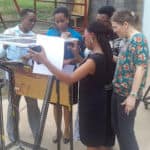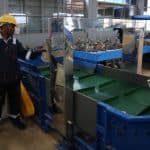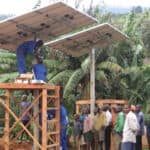Taking Cold Chains Off-Grid: How Solar Powered Cold Rooms Could Dramatically Reduce Food Waste in Sub-Saharan Africa
On a hot dry morning at the Kambi Mstuni farm in central Kenya, farm manager Jasper Etali happily emerges from his cold room unit. After months of troubleshooting issues with his newly acquired FreshBox solar-powered cold room, the system has been working properly for a whole week. With the functioning cold storage, Etali can sell an additional 1500 liters of milk to hotels in the capital, Nairobi.
Before investing in the FreshBox unit, Etali used traditional methods to keep milk cool overnight, submerging large metal milk jugs in drums of water. However, these drums were not as reliable as cold storage, and represented additional and recurring water and labour costs. According to the Food and Agriculture Organization, in sub-Saharan Africa, up to 40-50% of produce perishes before reaching the end customer, largely due to a lack of viable cold chain solutions.
This waste exacts a heavy toll in countries like Kenya, where compounding challenges like record rainfall and locust invasions threatened the food supply even before the economic crisis caused by COVID-19. But now, farmers and families living off-grid in developing countries are facing a COVID-19-triggered food emergency, resulting from supply chain disruptions and economic turmoil. The UN’s World Food Program estimates that the food insecure population could double to 265 million by the end of the year. Solar-powered cold rooms, like the one operated at Kambi Mstuni, can help address this crisis. They have the potential to significantly improve livelihoods for smallholder farmers and small traders by reducing the post-harvest loss of crops, increasing profits by boosting farmers’ bargaining power at the marketplace, and unlocking regional and international markets to smallholders in remote rural areas. However, the cold storage industry in sub-Saharan Africa faces significant technical and business model challenges that could undermine its potential impact.
WHAT’S NEEDED TO SCALE SOLAR POWERED COLD ROOMS
Through the implementation of the UKAid-funded Global LEAP Off-Grid Cold Chain Challenge (OGCCC), the Efficiency for Access Coalition, in partnership with Energy 4 Impact, gained insights into the opportunities and challenges for cold chain storage in food insecure regions. In 2018, the Challenge selected 10 finalist companies to set up and test solar-powered cold rooms in eight countries across sub-Saharan Africa. Of the finalists, only four (including FreshBox) were able to deploy their systems on the ground, which indicates the many difficulties that companies encounter when deploying nascent technologies in relatively new markets.

OGCCC Finalist ColdHubs unit in Imo State, Nigeria
Innovation in cold storage technologies and business models is critical to adjust to the needs and local conditions of customers in unique off-grid settings. Performance requirements for cold systems differ by crop and geographic location, among other factors. Therefore, where normal refrigerators provide broad cooling solutions, cold units must be designed to meet specific intended use cases. Technology providers also face critical and strategic choices around which technical components to use.
In the OGCCC, these choices are reflected in the decisions by finalist companies to use different materials for various cold system parts. For example, one participant used phase change material for thermal storage to bolster the autonomy of their unit (i.e.: to increase the length of time the unit could maintain the required temperature range when not connected to a power supply). Others used less efficient but more affordable clay bricks and recycled plastics for insulation, employed modified AC units for cooling (in place of more efficient but less affordable compressors), and used GSM-enabled remote monitors coupled with advanced Internet of Things technology and sensors for remote tracking. (This remote tracking allows preventive maintenance, which helps lower a unit’s operational costs.) Under COVID-19, technology providers will need to continue to innovate, leveraging locally available materials and technical capacity to overcome supply chain interruptions and meet the increasingly urgent need for safe, quality food during the crisis.
Implementing appropriate business models is also important to ensure the sustainability of cold storage solutions. On that front, the emerging Cooling as a Service (CaaS) model is particularly attractive, as it creates incentives that optimize efficiency and maintenance. CaaS is a business model in which the customer pays for cooling on a usage basis, rather than purchasing the cooling equipment directly. It requires little capital and minimal technical capacity on the part of the end user, which adds to its appeal. In the Challenge, one participating company used CaaS in a “pay-as-you-store” model, in which customers paid a daily fee for an allocated space in the cold room, marked by a tray or crates. To serve customers in multiple harvest seasons across different geographical areas, finalist companies also experimented with portable systems, which provide an opportunity to tap into refrigerated transportation.
Challenges and Solutions for the off-Grid Cold Chain Market
However, while developing appropriate technological solutions and business models is a step in the right direction, the off-grid cold chain market is not ready for scale. One prominent challenge involves how best to articulate and demonstrate the value proposition of cold chain interventions to the intended users of these systems – particularly in light of COVID-19. The pandemic has underscored the need for robust food storage solutions to help address loss and waste and ensure food quality. Meanwhile, the lockdown measures to contain the spread of coronavirus in many sub-Saharan African countries have interrupted normal food supply chains, preventing farmers from getting their produce to the market. In explaining the value proposition to farmers dealing with these challenges, it’s important to convey the trade-off between quality and the cost of off-grid cold storage systems. It’s also important to define what the baseline reliability standards for an off-grid cold storage system should be across different use cases.

OGCCC Finalist Ecolife, offering Cooling as a Service to vendors in Uganda
The OGCCC highlighted another challenge: end users’ lack of awareness of how to optimize their cold storage usage – e.g.: what temperature different crops must be stored at, and the importance of closing the cold unit door to maintain internal temperature. The need for consumer education and training on post-harvest best practices cannot be overemphasized – especially during COVID-19, when sanitation is paramount. Produce handling at the farmer level is critical to its quality and safe maintenance throughout the supply chain. Indirectly, improving the consumer education process will also help increase the product’s visibility, while building farmers’ confidence in investing in an often-unfamiliar solar-powered cold storage technology.
Besides the viability of the business model still presenting a challenge, the technology itself is also often not proven in the field. The cold storage providers encountered problems with inadequate power system sizing (including battery storage), faulty electronic parts, and connectivity issues with the remote monitoring system. It is therefore necessary for donors and investors to support more research and development activities on the ground, rather than in laboratories or similar stylized environments.
An additional challenge involves establishing an enabling business environment – something that’s crucial for any venture to thrive. For off-grid cold chains, this environment should ideally be characterized by:
- Access to favorably designed financial product offerings for early-stage businesses;
- Supportive policy frameworks for nascent technologies aimed at productive use;
- Access to supportive technologies for business, such as remote monitoring units;
- Well-developed rural – urban transport infrastructure;
- Easy access to market information and security
In order to make this a reality, the following interventions should be implemented: As a start, financial institutions and investors should design and offer financial products that are easy for small businesses to access, such as patient capital, de-risking through first-loss facilities, and results-based financing mechanisms. This will ensure that companies and businesses have increased access to appropriate funding needed to undertake R&D activities, invest in relevant human capital and operate their business. Governments should begin negotiations to establish policies spelling out clear and easy-to-follow legal procedures and requirements for businesses, coupled with incentives such as reduced import taxes. In addition, sub-Saharan African countries will need to direct more investment towards developing their internal transport infrastructure and boosting security. Initiatives like the OGCCC can be used to build up market and technology data, by undertaking more field-testing and market analysis studies and encouraging innovation around enabling technologies, such as digital platforms for remote monitoring. The combined efforts described above would contribute greatly towards preventing food losses and scarcity, especially in developing countries whose economies are integrally linked with agriculture.
We are hopeful that these types of interventions will soon be realized in a coordinated way, incorporating the main players in the sector – from technology providers and off-takers to donors and governments – to strengthen food security and resilience to adverse events in sub-Saharan Africa. The coronavirus pandemic we are currently experiencing has served to remind us of the urgency of this need.
The OGCCC falls under the UK Aid-funded Ideas to Impact program, managed by an IMC Worldwide-led consortium to test whether innovation inducement prizes can stimulate innovative solutions to longstanding development challenges for low-income households.
Maria Knodt is a Programme Manager at Energy 4 Impact; and Ruth Kimani is an Associate for Clean Energy Access at CLASP.
Photo courtesy of Maria Knodt and Ruth Kimani.
- Categories
- Agriculture, Coronavirus, Energy, Finance, Investing, Technology, Transportation



